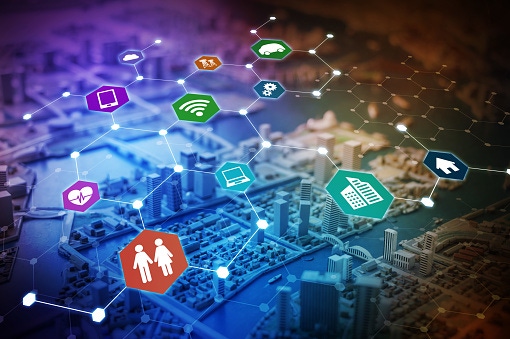IoT-as-a-service models are driving growth, but enterprises are still tentative. Here are some reasons to consider the model.
January 17, 2020

By Bill Kleyman
IoT as a service may be a trend in 2020 that you can’t ignore.
Before we dive into door sensors or Roombas-as-a-Service, let’s pause and look at the as-a-service market in general. The as-a-service market isn’t new. And, for many who use as-a-service models, there are ample cost and efficiency benefits.
When a product is sold as a service, the model allows customers to use only those resources they need at the time. As a result, as a service models are great for scenarios with variable demand: where there are sudden spikes in customer need. As-a-service models also enable customers to rapidly set up and tear down resources and to pay as they go rather than incur major capital costs up-front.
The as-a-service model has driven growth. A recent IDC report indicated that the worldwide cloud (SaaS) services market grew 27.4% year over year in 2018 with revenues totaling nearly $183 billion; a growth rate that’s more than 4.5 times that of the IT industry overall.
“Software as a Service (SaaS) continued to be the most highly deployed cloud segment, representing a commanding 62.4% of the total cloud market revenues, ” said Frank Della Rosa, research director, Software as a Service at IDC.
But if we replace applications, virtual services and cloud solutions with physical Internet of Things (IoT) devices? As edge computing, 5G and connected systems continue to grow in our market, is there a place for IoT as a Service?
The Market is Ready to Help You Manage Your Connected Devices
The short answer is yes, there will definitely be a market to help you control, manage and deliver connected devices-as-a-service. But it will depend on your goal. IoT as a-service is already in the wild and being adopted by a number of organizations.
Here are some real-world examples:
Connected microgrids. With the proliferation of natural disasters—from floods to wildfires— many organizations have gone beyond traditional generators as sources of power in times of emergencies and are exploring microgrids. A microgrid is a self-sufficient energy system that serves a discrete geographic area, such as a college campus, hospital complex or neighborhood. New microgrid technologies completely manage the grid for you too. One microgrid company offers a solution for California resiliency challenges with a reliable, clean, utility-grade backup power solution for large commercial and industrial facilities facing extended outages. The company connects the microgrid and manages it by identifying problems, suggesting maintenance and monitoring the performance of the unit. Integrated machine learning and data analytics forecast problems and power spikes. When it comes to power solutions like these, it’s critical to stay up and running. This IoT as a service solution goes from reactive to proactive as it leverages data feeds and insights to keep power grids up and running.
Connected cooling and airflow systems. These systems can reside at a manufacturing facility, a hospital, or anywhere that requires a proactive eye on ensuring cooling and good airflow. An Israeli manufacturer designed a connected air conditioning unit to report malfunctions back to the company so it is aware that a unit needs a repair. Major U.S. appliance manufacturers are in the mix as well.
Connected utilities. This is a huge IoT as a service use case. Smart metering at home enables a utilities company to provide more accurate readings and even when to service a neighborhood. Existing smart gas meters help natural gas suppliers address challenges such as unstable data transmission, high power consumption and even low metering success rates. To get to that point, however, connected meters need an architecture to support it, such as Narrowband Internet of Things (NB-IoT) technology to deliver security, wide coverage, massive connectivity and low power consumption—cost-effectively.
Other IoT as a Service offerings provide knowledge. For example, a major cloud provider offers IoT Central. This platform assists enterprises with the deployment of Internet of Things (IoT) applications without the need for in-house expertise. Early adopters include ThyssenKrupp Elevator, Sandvik Coromant and Rolls-Royce.
These kinds of IoT-as-a-service models aim to make it easy to manage and deploy connected devices. You’ll experience central device management, including advanced rules and analytics, that’ll help you fix, update, and reconfigure devices. From there, IoT-aaS solution will further help you scale, and even monetize your connected ecosystem.
As great as handing over the keys to your connected devices might seem, there can be some challenges. First, you need to understand how data from these devices will traverse the cloud, the managed services partner and customers. If you’re in an industry subject to regulation, you’ll need to understand how your partner will manage transient data these devices generate. This will be a nonstarter if this company stores or processes personal health information or personally identifiable information unless it’s expressly able to do so. This also highlights the need for proper security measures to be applied to data. Validate your partner’s capabilities to manage growth, data integrity and business strategy moving forward. If this is an undertaking, understand how data is segmented, how networks are designed, and where data will be processed or stored. Remember, IoT devices are absolutely targets for the bad guys.
Another challenge is latency and performance. If your IoT-as-a-service provider processes data from devices, but doesn’t have a good edge platform or IoT-enabled architecture, you may confront performance and latency issues. Remember, some IoT devices require sub-millisecond, capabilities. Be sure your partner can handle your requirements.
I Want to Invest in IoT as a Service: Now What?
If this is an area your company wants to consider it will depend on your connected devices and your business approach. Here are some steps:
Consider your physical devices and how they’ll interact with users as well as the software layer, and data management.
Consider your business objective in using an as-a-service model.
Select metrics so you can determine whether you are meeting your business goals and measure according to these key performance indicators as you use the as-a-service model.
Address the security needs of your data to ensure data security and regulatory compliance.
Select an entire platform to manage your IoT devices (such as IoT Central), or use specific connected devices for your own needs, such as connected microgrids or cooling systems, for example.
The IoT-as-a-service market isn’t as immature as some believe. There are real-world projects where service providers manage the physical devices (along with the data they produce). Further, the companies that can clearly define their managed IoT strategies will benefit most from monetization and competitive advantage.
In the near future, our world will be more connected and interactive. We’re quickly bringing digital life to once-analog systems; and that will require a new way of managing these technologies, along with controlling the data that flows through them. If connected systems or devices are in your future, consider how you want to manage and deliver those services. You will need staff and expertise, and you will need to ensure that these devices are patched and updated.
It’s important to start the design process now and get the right partners in place to help your IoT-a-a-service strategy take off.
You May Also Like
.png?width=700&auto=webp&quality=80&disable=upscale)
.png?width=700&auto=webp&quality=80&disable=upscale)

.png?width=300&auto=webp&quality=80&disable=upscale)
.png?width=300&auto=webp&quality=80&disable=upscale)
.png?width=300&auto=webp&quality=80&disable=upscale)
